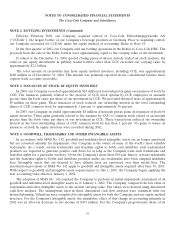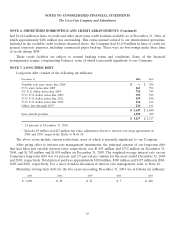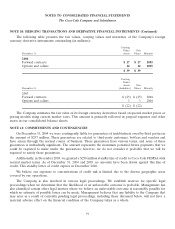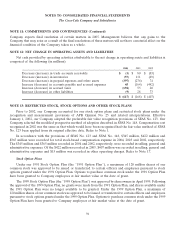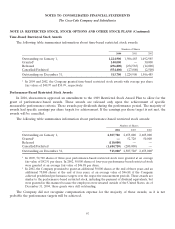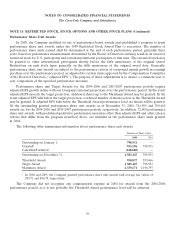Coca Cola 2004 Annual Report Download - page 90
Download and view the complete annual report
Please find page 90 of the 2004 Coca Cola annual report below. You can navigate through the pages in the report by either clicking on the pages listed below, or by using the keyword search tool below to find specific information within the annual report.NOTES TO CONSOLIDATED FINANCIAL STATEMENTS
The Coca-Cola Company and Subsidiaries
NOTE 10: HEDGING TRANSACTIONS AND DERIVATIVE FINANCIAL INSTRUMENTS (Continued)
transactions. The Company formally assesses, both at the inception and at least quarterly thereafter, whether the
financial instruments that are used in hedging transactions are effective at offsetting changes in either the fair
value or cash flows of the related underlying exposure. Because of the high degree of effectiveness between the
hedging instrument and the underlying exposure being hedged, fluctuations in the value of the derivative
instruments are generally offset by changes in the fair values or cash flows of the underlying exposures being
hedged. Any ineffective portion of a financial instrument’s change in fair value is immediately recognized in
earnings. Virtually all of our derivatives are straightforward over-the-counter instruments with liquid markets.
Our Company does not enter into derivative financial instruments for trading purposes.
The fair values of derivatives used to hedge or modify our risks fluctuate over time. We do not view these
fair value amounts in isolation, but rather in relation to the fair values or cash flows of the underlying hedged
transactions or other exposures. The notional amounts of the derivative financial instruments do not necessarily
represent amounts exchanged by the parties and, therefore, are not a direct measure of our exposure to the
financial risks described above. The amounts exchanged are calculated by reference to the notional amounts and
by other terms of the derivatives, such as interest rates, exchange rates or other financial indices.
Our Company recognizes all derivative instruments as either assets or liabilities in our consolidated balance
sheets at fair value. The accounting for changes in fair value of a derivative instrument depends on whether it
has been designated and qualifies as part of a hedging relationship and, further, on the type of hedging
relationship. At the inception of the hedging relationship, the Company must designate the instrument as a fair
value hedge, a cash flow hedge, or a hedge of a net investment in a foreign operation. This designation is based
upon the exposure being hedged.
We have established strict counterparty credit guidelines and enter into transactions only with financial
institutions of investment grade or better. We monitor counterparty exposures daily and review any downgrade
in credit rating immediately. If a downgrade in the credit rating of a counterparty were to occur, we have
provisions requiring collateral in the form of U.S. government securities for substantially all of our transactions.
To mitigate presettlement risk, minimum credit standards become more stringent as the duration of the
derivative financial instrument increases. To minimize the concentration of credit risk, we enter into derivative
transactions with a portfolio of financial institutions. The Company has master netting agreements with most of
the financial institutions that are counterparties to the derivative instruments. These agreements allow for the
net settlement of assets and liabilities arising from different transactions with the same counterparty. Based on
these factors, we consider the risk of counterparty default to be minimal.
Interest Rate Management
Our Company monitors our mix of fixed rate and variable rate debt, as well as our mix of term debt versus
non-term debt. This monitoring includes a review of business and other financial risks. We also enter into
interest rate swap agreements to manage these risks. These contracts had maturities of less than one year on
December 31, 2004. Interest rate swap agreements that meet certain conditions required under SFAS No. 133
for fair value hedges are accounted for as such, with the offset recorded to adjust the fair value of the underlying
exposure being hedged. During 2004, 2003 and 2002, there has been no ineffectiveness related to fair value
hedges. The fair values of our Company’s interest rate swap agreements were approximately $6 million and
$28 million at December 31, 2004 and 2003, respectively. The Company estimates the fair value of its interest
rate management derivatives based on quoted market prices.
88



